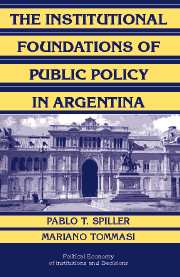Book contents
- Frontmatter
- Contents
- Acknowledgments
- Introduction
- I An Intertemporal Approach to Policy Making
- II The Workings of Political Institutions, Policy Making, and Policies in Argentina
- 3 Congress, Political Careers, and the Provincial Connection
- 4 Federalism, Argentine Style
- 5 The Supreme Court
- 6 The Bureaucracy
- 7 The Nature of Public Policies in Argentina
- Concluding Remarks
- References
- Index
- POLITICAL ECONOMY OF INSTITUTIONS AND DECISIONS
4 - Federalism, Argentine Style
Published online by Cambridge University Press: 17 March 2011
- Frontmatter
- Contents
- Acknowledgments
- Introduction
- I An Intertemporal Approach to Policy Making
- II The Workings of Political Institutions, Policy Making, and Policies in Argentina
- 3 Congress, Political Careers, and the Provincial Connection
- 4 Federalism, Argentine Style
- 5 The Supreme Court
- 6 The Bureaucracy
- 7 The Nature of Public Policies in Argentina
- Concluding Remarks
- References
- Index
- POLITICAL ECONOMY OF INSTITUTIONS AND DECISIONS
Summary
Federalism in general and fiscal federalism in particular are crucial axes of Argentina's history, of Argentina's present, and of Argentina's possible futures. This chapter provides a brief description of some basic characteristics of federalism in Argentina, with focus on many deficiencies of federal fiscal arrangements. Then it applies the analytical framework developed in Part I to explain those inefficiencies as the dynamic outcome of a game among the national government and provincial governments. This gaming around federal fiscal issues (the distribution of taxes, transfers, and spending responsibilities) permeates national and subnational policy making in crucial policy areas such as the social sectors.
The 2001 article from Business Week reproduced here provides some vivid examples of the importance of fiscal federalism and intergovernmental politics in Argentina:
To investors in emerging markets, 2001 could well be the year of Argentina. Fears that Latin America's third-largest economy might default on its $123 billion public debt have eased, thanks to a $39.7 billion Christmas gift from the International Monetary Fund. But it's now up to President Fernando de la Rúa to prove to the fund that Argentina can sort out its finances. If he fails, the consequences could be dire for bourses from Buenos Aires to Moscow.
Yet the key to Argentina's success in this grim struggle doesn't lie in the presidential palace. Instead, investors must pay close attention to what happens in Argentina's interior. It's the far-flung provinces, with their budget-busting spending, that have helped push the country to the brink. De la Rúa, as part of his bid for IMF aid, has extracted a hard-won pledge from Argentina's 23 governors to freeze expenditures for five years. […]
- Type
- Chapter
- Information
- The Institutional Foundations of Public Policy in ArgentinaA Transactions Cost Approach, pp. 89 - 121Publisher: Cambridge University PressPrint publication year: 2007
- 2
- Cited by

